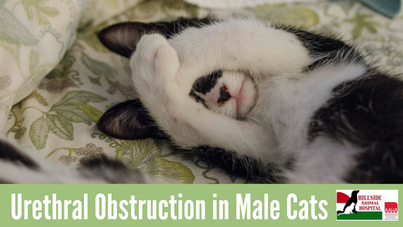Just when you think you have your male cat figured out, there he is standing there, squatting in the middle of your bedroom floor and staring oddly at you. “Boots, what has gotten into you?”, you say as you cock your head and stare back at him. Then he meows in a strange tone and leaves a drop of blood on the floor. You follow him to his litter box where he continues to strain with little to no urine production. If this is a scene you have never before witnessed, but if you have a male cat, be warned. This scenario is actually an emergency situation! Boots likely has a urethral obstruction. At some point between his urinary bladder and the outside world is something creating a blockade in his urethra, which will not allow urine to pass through. Urethral obstructions are more common in male cats than you may think. If left untreated this condition can ultimately lead to death due to severe dehydration and electrolyte imbalance.
What causes this to happen?
The urethra can be obstructed due to a bladder stone(s), an accumulation of urinary crystals, scarring, or simply muscle spasms and/or swelling. When an obstruction occurs we may find that underlying reasons are related to environmental stress (recent move, construction on the house, interactions with other household cats, ect.), obesity, and/or lack of adequate water intake.
What do I do if this happens?
Call a vet. Right away. Even if it is the middle of the night. Someone is always available to help. Remember, this is an emergency. Your cat needs to be evaluated and if obstructed, he will need a urinary catheter placed to allow urine to flow freely again. Once in place he will need this catheter to stay in for approximately 24- 48 hours, or until the urine becomes a clear yellow. Your veterinarian will also ensure that he is rehydrated and comfortable by administering fluids intravenously and that he is given medication to relieve his pain. After his stay in the hospital, you will need to closely monitor Boots at home to make sure that he is producing an adequate amount of urine in the litter box. Your veterinarian will likely discuss altering his diet and/or lifestyle to prevent this from happening again.
Urinary issues in cats are common and do not always lead to an obstruction, but should be addressed with a veterinarian as soon as they are noticed so that your veterinarian can start treatment before his issues lead to an obstruction.

